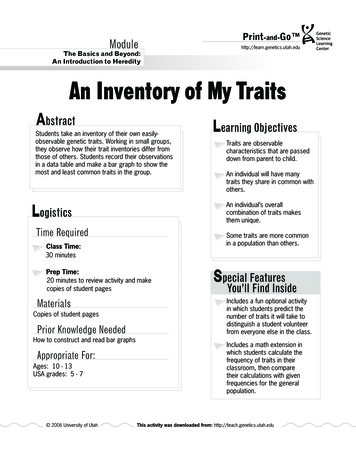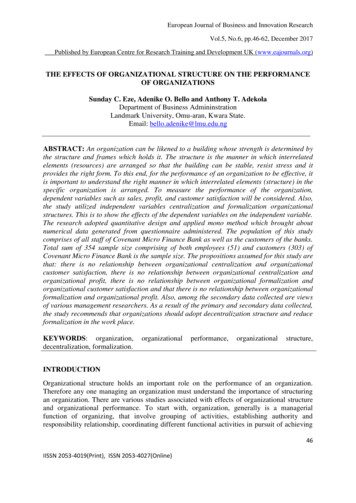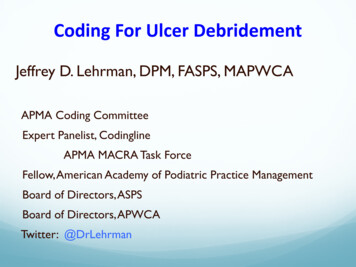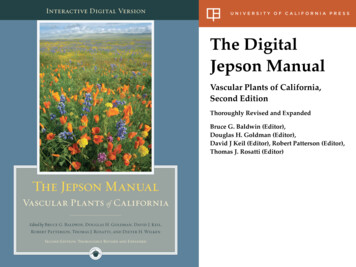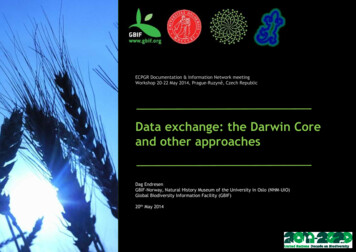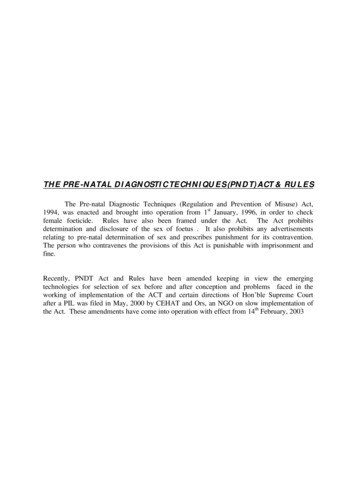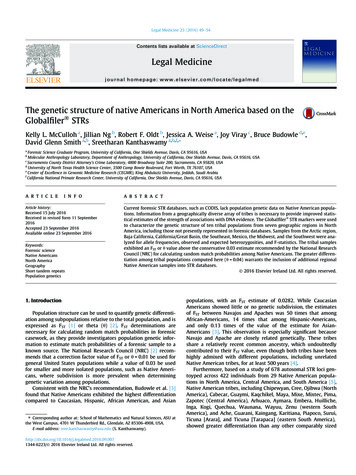
Transcription
Legal Medicine 23 (2016) 49–54Contents lists available at ScienceDirectLegal Medicinejournal homepage: www.elsevier.com/locate/legalmedThe genetic structure of native Americans in North America based on theGlobalfilerÒ STRsKelly L. McCulloh a, Jillian Ng b, Robert F. Oldt b, Jessica A. Weise a, Joy Viray c, Bruce Budowle d,e,David Glenn Smith a,b, Sreetharan Kanthaswamy a,b,f, aForensic Science Graduate Program, University of California, One Shields Avenue, Davis, CA 95616, USAMolecular Anthropology Laboratory, Department of Anthropology, University of California, One Shields Avenue, Davis, CA 95616, USASacramento County District Attorney’s Crime Laboratory, 4800 Broadway Suite 200, Sacramento, CA 95820, USAdUniversity of North Texas Health Science Center, 3500 Camp Bowie Boulevard, Fort Worth, TX 76107, USAeCenter of Excellence in Genomic Medicine Research (CEGMR), King Abdulaziz University, Jeddah, Saudi ArabiafCalifornia National Primate Research Center, University of California, One Shields Avenue, Davis, CA 95616, USAbca r t i c l ei n f oArticle history:Received 15 July 2016Received in revised form 11 September2016Accepted 23 September 2016Available online 23 September 2016Keywords:Forensic scienceNative AmericansNorth AmericaGeographyShort tandem repeatsPopulation geneticsa b s t r a c tCurrent forensic STR databases, such as CODIS, lack population genetic data on Native American populations. Information from a geographically diverse array of tribes is necessary to provide improved statistical estimates of the strength of associations with DNA evidence. The GlobalfilerÒ STR markers were usedto characterize the genetic structure of ten tribal populations from seven geographic regions in NorthAmerica, including those not presently represented in forensic databases. Samples from the Arctic region,Baja California, California/Great Basin, the Southeast, Mexico, the Midwest, and the Southwest were analyzed for allele frequencies, observed and expected heterozygosities, and F-statistics. The tribal samplesexhibited an FST or h value above the conservative 0.03 estimate recommended by the National ResearchCouncil (NRC) for calculating random match probabilities among Native Americans. The greater differentiation among tribal populations computed here (h 0.04) warrants the inclusion of additional regionalNative American samples into STR databases.Ó 2016 Elsevier Ireland Ltd. All rights reserved.1. IntroductionPopulation structure can be used to quantify genetic differentiation among subpopulations relative to the total population, and isexpressed as FST [1] or theta (h) [2]. FST determinations arenecessary for calculating random match probabilities in forensiccasework, as they provide investigators population genetic information to estimate match probabilities of a forensic sample to aknown source. The National Research Council (NRC) [2] recommends that a correction factor value of FST or h 0.01 be used forgeneral United States populations while a value of 0.03 be usedfor smaller and more isolated populations, such as Native Americans, where subdivision is more prevalent when determininggenetic variation among populations.Consistent with the NRC’s recommendation, Budowle et al. [3]found that Native Americans exhibited the highest differentiationcompared to Caucasian, Hispanic, African American, and Asian Corresponding author at: School of Mathematics and Natural Sciences, ASU atthe West Campus, 4701 W Thunderbird Rd., Glendale, AZ 85306-4908, USA.E-mail address: sree.kanthaswamy@asu.edu (S. 2016.09.0071344-6223/Ó 2016 Elsevier Ireland Ltd. All rights reserved.populations, with an FST estimate of 0.0282. While CaucasianAmericans showed little or no genetic subdivision, the estimatesof FST between Navajos and Apaches was 50 times that amongAfrican-Americans, 14 times that among Hispanic-Americans,and only 0.13 times of the value of the estimate for AsianAmericans [3]. This observation is especially significant becauseNavajo and Apache are closely related genetically. These tribesshare a relatively recent common ancestry, which undoubtedlycontributed to their FST value, even though both tribes have beenhighly admixed with different populations, including unrelatedNative American tribes, for at least 500 years [4].Furthermore, based on a study of 678 autosomal STR loci gentoyped across 422 individuals from 29 Native American populations in North America, Central America, and South America [5],Native American tribes, including Chipewyan, Cree, Ojibwa (NorthAmerica), Cabecar, Guaymi, Kaqchikel, Maya, Mixe, Mixtec, Pima,Zapotec (Central America), Arhuaco, Aymara, Embera, Huilliche,Inga, Kogi, Quechua, Waunana, Wayuu, Zenu (western SouthAmerica), and Ache, Guarani, Kaingang, Karitiana, Piapoco, Surui,Ticuna [Arara], and Ticuna [Tarapaca] (eastern South America),showed greater differentiation than any other comparably sized
50K.L. McCulloh et al. / Legal Medicine 23 (2016) 49–54population (FST or h 0.08). Therefore, the FST estimate from Wanget al. [5] suggests a higher FST than the 0.03 value currently recommended by the NRC [2] will be needed to adjust for populationstructure in forensic cases, including paternity testing, involvingNative American individuals. To establish an informative NativeAmerican population database, a more detailed examination isnecessary to determine whether significant differentiation existsto warrant the creation of additional Native American datasets.Given that the CODIS Native American STR database lacks tribesthat are genetically similar to the vast majority of tribes livingtoday and that geography is responsible for 60% of genetic differentiation [6], it is necessary to generate information for a more geographically diverse representation of additional tribes representinga greater number of geographic populations to better characterizegenetic variation among Native Americans [4].The current 13 CODIS loci are CSF1PO, FGA, TH01, TPOX, VWA,D3S1358, D5S818, D7S820, D8S1179, D13S317, D16S539, D18S51,and D21S11 [7]. This study included eight additional autosomalloci (D1S1656, D2S441, D2S1338, D10S1248, D12S391, D19S433,D22S1045, and SE33), which are included in the GlobalfilerÒ PCRAmplification Kit (Applied Biosystems, Foster City, CA), and areincluded in the expanded CODIS core loci [8]. Profiling new NativeAmerican samples with these 21 loci will expand the existing poolof genetic profiles in the DNA database and provide more information on allele frequencies and population substructures. In addition, this study focused on the effect of geographic location onpopulation structure and differentiation and quantified such variation. The STR typing of the geographically representative NorthAmerican tribes from the Arctic region, Baja California, California/Great Basin, the Southeast, Mexico, the Midwest, and the Southwest establishes a more complete Native American database thatcan directly assist in forensic investigations as well as providemore reliable estimates of allele frequencies and genetic variationwithin and among the tribes.2. Materials and methodsThe Department of Anthropology Laboratory at UC Davis housesone of the largest databanks of geographically and linguisticallyrepresentative full blood Native North American samples. Of the3327 tribal DNA samples currently archived and available at theDepartment of Anthropology at UC Davis, the 418 samples fromrandom individuals analyzed here were the only ones that metthe quantification requirements for STR analysis. Prior approvalfrom the UC Davis IRB (ID 430207-2) was obtained for the use ofthese samples for this study. The list of 418 tribal samples includedin the study, as well as their geographic origins and mtDNA haplogroup distributions are shown in Table 1. In North America, haplogroup frequencies exhibit regional continuity that can be helpfulin understanding relationships among the populations in thoseareas [9]. The geographical regions of the Native American tribesused in this study were based on Driver [10] and Lorenz and Smith[11]. Samples from the Southwest, Southeast, Midwest/GreatPlains and Arctic region as well as samples from California/GreatBasin, Baja California, and Mexico were included in this study.2.1. Sample extractionSamples consisting of serum, buffy coat, blood, or purified DNAwere originally stored at 20 C but have recently been maintainedat 4 C. DNA samples were extracted from serum, buffy coat, andblood samples using the QIAamp DNA Blood Mini Kit (QIAGEN,Redwood City, CA) following the manufacturer’s protocol.2.2. Sample quantificationDNA samples were quantified using the QuantifilerÒ Duo Quantification Kit and the 7500 Fast Real-time PCR system (AppliedBiosystems). The quantification standards and DNA samples wereboth run in duplicate following the manufacturer’s protocol.2.3. Sample amplificationDNA samples were diluted to 1.0 ng/lL and amplified alongwith the National Institute of Standards and Technology (NIST)Standard Reference Material (SRM) 2391c reference DNA sampleusing the GlobalfilerÒ PCR Amplification Kit (Applied Biosystems)according to the manufacturer’s protocols. Amplified samples werediluted in Hi-Di Formamide (Applied Biosystems) and run on a3130xl Genetic Analyzer with POP-4 polymer (Applied Biosystems)following manufacturer recommended parameters. The GeneScanTM 600 LIZÒ Size Standard (Applied Biosystems) was used asthe internal sizing standard and the GlobalfilerÒ Allelic Ladder(Applied Biosystems) was used for sizing the alleles. Alleles werecalled using GeneMapperID-X v.1.4 (Applied Biosystems) withthe Local Southern sizing method.2.4. Statistical or other methods of data analysesThe extent of genetic variation within and among tribal samples, number of alleles, and observed and expected heterozygosityfor each autosomal locus in each geographic region were calculatedusing Arlequin v3.5.1.2 [12]. Arlequin was also used to calculatethe following F-statistics: FST – the proportion of genetic variancein a population that is due to differences among subdivisionswithin that population; FIS – inbreeding coefficient, FIT: totalinbreeding coefficient, and pairwise FST – to assess the degree ofdifferentiation between pairs of tribal samples which provides aninsight into the historical connections among tribal samples andamong the geographic regions these tribes represent. The statisti-Table 1The seven geographic samples represented by 10 tribes, their sample sizes (N), and mtDNA haplogroup frequencies. Tribes in the southwest US region of North America, such asApache and Yavapai, have a high frequency of haplogroup B, a moderate frequency of haplogroup C, and low frequencies of haplogroups A, D, and X [11], while a few tribes in thenorthern half of Mexico, such as Huichol, and Cora, have lower frequencies of A, suggesting gene flow between the North American Southwest and Mexico [24].Geographic regionTribeNABCDXRefs.ArcticBaja CACA/Great uthwest
51K.L. McCulloh et al. / Legal Medicine 23 (2016) 49–54cal significance of the pairwise FST computations was determinedwith a probability distribution constructed from permutation tests(N 1000) with Bonferroni corrections for multiple comparisons.Mann-Whitney U tests were performed to determine ifpopulation-specific estimates of diversity and FIS differed significantly across populations and from the overall average. TheHardy-Weinberg Exact Test in the program GENEPOP 4.2 was usedto determine if any of the tribal samples showed detectable deviations from expectations of equilibrium [13,14]. CONVERT v1.31[15] was used to compute private allele frequencies (or allelesrestricted to one group) at each locus within each geographicallyseparate sample. Because differences in sample size can affectallele representation and estimates of genetic variation (particularly due to the presence or absence of rare alleles), each of thegenetic parameters was recalculated using 1000 iterations of 21randomly selected individuals from each tribe (Table 1) normalized to match that of the Chippewa tribe (N 21).3. ResultsThe Supplementary Table 1 presents allele frequencies acrossthe 21 autosomal STR loci for each geographical region and the frequencies of the 10 individual tribes included in this study havebeen published in Ng et al. [16]. Table 2 presents the estimatesof allele numbers (Na), and observed (OH) and expected (EH)heterozygosities across the geographic regions for all 21 STRs.The tribal samples averaged between 6 (Eskimo – Arctic) and 8(Miwok – CA/Great Basin, Cherokee – Southeast, Cora – Mexico,and Apache (San Carlos Apache Reservation) and Yavapai – Southwest) alleles per locus. Estimates of allele numbers, both rare andcommon, based on 21 random individuals from each tribe suggestan influence of sample size; the difference between Na based ontotal sample and the sample of 21 is greatest for those tribes withthe largest sample size (i.e., Cora – Mexico, and Apache and Yavapai – Southwest). The values of OH and EH in Table 2 did notappear to be influenced by sample size. OH values range from0.68 (Eskimo – Arctic) to 0.78 (Miwok – CA/Great Basin) whileEH values range from 0.69 (Eskimo – Arctic) to 0.77 (Cherokee –Southeast). Several private alleles among the tribes were identifiedwith the Cherokee (Southeast) sample having the most (10), followed by Chippewa (Midwest – 5), Apache (Southwest – 5), Cora(Mexico – 5), Miwok (CA/Great Basin – 5), Yavapai (Southwest –4), Huichol (Mexico – 1), and Seri (Mexico – 1) (Table 3). Frequencies of private alleles ranged from 0.006 to 0.005 (Table 3).Pairwise FST, as well as population-specific FST, and average FISare shown in Table 4; all pairwise FST p-values were statisticallysignificant at the 0.05 level. Pairwise FST values from Table 4 suggest that differentiation among Native American tribes rangedfrom 0.006 (between Apache and Yavapai – Southwest) to 0.113Table 3Private alleles observed in this study: Midwest (5), CA/Great Basin (5), Mexico (7),Southwest (9), and Southeast (10).LocusSizeTribe (Geographic 31917.319.3Chippewa (Midwest)Apache (Southwest)Cherokee (Southeast)Cherokee (Southeast)Miwok (CA/Great Basin)Miwok (CA/Great Basin)Apache (Southwest)Yavapai (Southwest)Cherokee (Southeast)Cherokee (Southeast)Apache (Southwest)Cherokee (Southeast)Huichol (Mexico)Cherokee (Southeast)Yavapai (Southwest)Miwok (CA/Great Basin)Cora (Mexico)Cora (Mexico)Miwok (CA/Great Basin)Chippewa (Midwest)Cora (Mexico)Cherokee (Southeast)Chippewa (Midwest)Cherokee (Southeast)Cora (Mexico)Yavapai (Southwest)Yavapai (Southwest)Apache (Southwest)Cherokee (Southeast)Apache (Southwest)Chippewa (Midwest)Cherokee (Southeast)Chippewa (Midwest)Seri (Mexico)Miwok (CA/Great Basin)Cora 0160.0060.0240.0300.0240.0350.0460.008(between Eskimo – Arctic and Seri – Mexico). In addition toexhibiting the greatest levels of differentiation with each other,the Eskimo (Arctic) and Seri (Mexico) populations also exhibitedthe greatest differences from most of the study samples, withmean pairwise FST values of 0.073 and 0.070, respectively. The Arctic sample also showed genetic differences from other geographicsamples that were correlated with geographic distance. Differentiation within the Continental US did not appear to be correlatedwith their geographical distances. Within Mexico, the mean pairwise FST among the Cora, Huichol, and Seri was approximately0.05 with Cora and Huichol exhibiting the least differences (0.02)and Seri appearing to be the most genetically isolated. When theCochimi tribe from Baja California was compared with the otherTable 2Allele number (Na), observed (OH) and expected (EH) heterozygosities for each tribe and geographic sample. Estimates based on 21 randomly chosen samples parenthesizedshow that sample size has not affected the analyses significantly. *Indicates tribal populations that conformed with HWE at p 0.01 when all samples were included in theanalyses. None of these populations deviated from HWE at p 0.01 when 21 random samples from each population were analyzed.Geographic regionTribeNNaOHArcticBaja CACA/Great uthwestEskimoCochimiMiwokCherokeeCora Huichol Seri Chippewa ApacheYavapai 0.700.660.770.730.7441.8 (21)7.2 (6.5)Average )0.73 (0.71)0.73 (0.73)
52K.L. McCulloh et al. / Legal Medicine 23 (2016) 49–54Table 4Pairwise and population specific FST and FIS based on the 22 autosomal STR loci in the seven geographic samples. Estimates based on 21 randomly chosen samples are above thediagonal. The overall F-statistics for all populations are FIS 0.006 (0.014), FST 0.039 (0.041), and FIT 0.045 (0.056), where parenthesized values are estimates based on the 21random oCochimi(BajaCalifornia)Miwok )0.034(0.03)0.040(0.04)0.008(0.02)0.043( 0.05)0.020( 0.02)0.006(0.04)0.011( 20.0370.0270.0230.0440.0520.014samples from Mexico, a range of pairwise FST from 0.02 (CochimiCora) to 0.068 (Cochimi-Seri) was observed. It appears that geographic and genetic distances between Mexico and the other studysamples are correlated.FIS values (Table 4) were highest for the Cora tribe from Mexico(FIS 0.04), followed by the Cherokee tribe (Southeast) and Eskimo(Arctic) samples (FIS 0.034 and 0.017, respectively). The othertribes exhibited either low (nearing zero) levels of FIS values ornone at all (negative values).4. DiscussionLarger sample sizes tended to be more optimal than smallerones for finding the most alleles or for computing genetic diversityestimates; for instance the decline in Na when samples of size 21were analyzed is greatest for the largest sample sizes (i.e., Cora –Mexico, and Apache and Yavapai – Southwest). The same averagenumber of 8 alleles per locus was observed in this study as inthe Budowle et al. studies [3,17] which also used Apache andEskimo samples albeit with much greater sample numbers. In spiteof having screened many more individuals from the Apache, Athabaskan, Inupiat, and Yupik tribes, i.e. at least twice as many usedhere, Budowle et al. [3] reported slightly lower OH (0.70) as wellas EH (0.71) in the Apache tribe and comparable OH and EH estimates among the Alaskan tribes; OH 0.70 and average EH 0.71.Private STR alleles with a maximum frequency of 5% have beenestimated in the present study. While no private allele with a frequency above 0.13 has been found [18], with the exception of anine repeat allele (9RA) in D9S1120 which occurs at a high averagefrequency of 0.36 among tribal samples [19–21], the determinationof population specific private alleles in this study, ranging from 1(in the Seri and Huichol tribes of Mexico, respectively) to 10 (inthe Cherokee from the Southeast) could further assist forensicinvestigators given their potential to differentiate tribal samplesand to find perpetrators of specific tribal origin.The higher FST values of the Arctic region for average and acrossall pairwise comparisons reflect the population’s relative geographic isolation from the other populations. A Mann-Whitney Utreatment of the heterozygosity and FIS estimates revealed0.0120.006significantly (p 0.05) lower heterozygosity estimates of the Arcticpopulation (OH 0.68 and EH 0.69) in relation to the averageacross all other populations (OH 0.73 and EH 0.73). The higherFIS value as compared to the total population average can beattributed to a lack of migration and an increase of non-randommating that also stems from genetic isolation. The Arctic population’s low nuclear genetic variation based on OH and EH estimatesis consistent with the population’s mtDNA variation, which isalmost exclusively mtDNA haplogroup A (average haplogroup Afrequency 0.97) [22].In contrast to the Arctic population, other Native American populations have a wider range of mtDNA haplogroups (predominantly A, B, C, and D) with a few tribes having higher frequenciesof haplogroup X [9] and an average FST value of 0.05, which ishigher than all other sample comparisons if the Arctic tribe wasnot included. In Mexico, the Seri, Cora, and Huichol tribes, especially the Seri who have a relatively high tribe-specific FST value0.07, are more isolated from the rest of the Mexican tribes sincethey live in inaccessible places, preserve their customs, and onlyreproduce among themselves [9].The lower differentiation (pairwise FST 0.02) between Cochimi(Baja CA) and Miwok (CA/Great Basin) compared to the differentiation between the former and Mexico (FST 0.04) is consistentwith the theory that coastal migration brought populations tothe Baja peninsula [23]. The pairwise FST values between Baja CAand the rest of the populations (mean pairwise FST 0.05) also suggest that Baja CA is not significantly differentiated from the rest ofNorth America. The Yuman-speaking tribes of Baja California(including Cochimi, as well as Cucupa, Kiliwa, Kumiai, and PaiPai, which were not analyzed here) were moved to their currentlocation from their homeland in Mexico Proper, and are closelyrelated to the Yuman-speaking tribes of the American Southwest(e.g., Hualapai and Yavapai), which can explain the lack of differentiation among those regions.The Southwest (Apache and Yavapai) exhibited the lowestamount of differentiation (FST 0.02) with the Midwest (Chippewa), which suggests that a high rate of gene flow between theSouthwest and Midwest populations existed historically. MtDNAhaplogroup A-D and X frequencies observed in the Southwest,
K.L. McCulloh et al. / Legal Medicine 23 (2016) 49–54Mexico, and North America also are consistent with high levels ofgene flow among those regions [24]. Although the Southwest wasslightly differentiated from the CA/Great Basin and Baja CA (rangeFST 0.02–0.04) in this study, mtDNA haplogroup B, which is predominant in the Southwest, was also prevalent in the CA/GreatBasin and northern Mexico. Since mid-continental migration ofthe Midwest and Southeast populations occurred more recentlythan the Pacific coastal and coastal interior migrations [22,23],such as the Cochimi, Miwok, Huichol, and Seri, less differentiationis expected (FST 0.02 vs. FST 0.06). The Arctic had the leastamount of differentiation from the Midwest and Southeast (pairwise FST 0.05 and 0.06, respectively) compared to the other populations, suggesting those two populations were the last to divergefrom the Arctic.The Southeast population was least differentiated from theMidwest (pairwise FST 0.02) and CA/Great Basin populations(pairwise FST 0.01), suggesting a migration out of the Northwestrather than from the west, as Fladmark [23] proposed. The FIS valuefor the Midwest was 0.02, indicating a lack of genetic isolation,possibly due to migration through the Midwest into the Southeastafter the glacial recession. Migration through the Midwest wouldbring in excess gene flow and would increase the amount ofheterozygosity seen in that population. Alongside Mexico, theSoutheast exhibited a high FIS value (0.03), suggesting that population migration ended once the Atlantic Ocean was reached.The present study shows that Native Americans exhibit greateroverall inter-population differentiation (FST 0.04) than reportedby Budowle et al. [3] as would be expected with increased samplepopulations that are geographically heterogeneous. Wang et al.’s[5] study based on STRs (albeit not the CODIS STRs) computedFST values for the Americas that far exceeded the value obtainedherein, especially for Central and South American populations(FST 0.06 to 0.15). These tribes were not considered in the present study. However, they also observed a value of FST of 0.03among the North American tribes of Chipewyan, Cree, and Ojibwa.While the North American FST estimate reported by Wang et al.[5] is more consistent with that of Budowle et al. [3] than withthe present study, the three tribes in their study were all derivedfrom the same geographic region and belong to the same languagegroup [5]. Had these previous studies included more regionallyrepresentative unrelated tribes, their FST estimates would be atleast comparable if not greater than the estimates obtained inthe present study. Therefore, the present study does not supportthe NRC’s recommendations [2] for using a correction factor ofFST or h of only 0.03 for calculating match probabilities in smallisolated populations, such as the Native Americans. In fact, thepresent results show that a more stringent value of at least 0.04should be used.Since the CODIS Native American STR database contains onlytribes from the Arctic and Subarctic regions and does not includethe vast majority of other geographically diverse tribes, it is necessary to expand the database to include more unique genetic populations. Groups isolated by geography, such as the Arctic Eskimoand the Seri from Mexico, had the highest differentiation, whilegroups that have recently migrated out of the Northwest reportlow FST values. Expanding the study to include samples from Central and South America may increase the FST estimate [5]. AccurateFST values can help forensic investigators obtain more precise random match probabilities or make inferences of ethnic orgin incasework samples.AcknowledgementsThe research described in this article has been reported in KellyL. McCulloh’s Masters of Science (Forensic Science) thesis, whichwill be submitted to the UC Davis Office of Graduate Studies. The53authors wish to thank the two anonymous reviewers for their critical review of this manuscript that has resulted in its significantimporvement. This study was supported by a National Instituteof Justice – United States grant 2014-DN-BX-K024 to SK and aresearch grant to KM from the UC Davis Forensic Science GraduateProgram.Appendix A. Supplementary dataSupplementary data associated with this article can be found, inthe online version, at eferences[1] S. Wright, The interpretation of population structure by F-statistics withspecial regard to systems of mating, Evolution 19 (3) (1965) 395–420.[2] National Research Council, The Evaluation of Forensic DNA Evidence, TheNational Academies Press, Washington DC, 1996.[3] B. Budowle, B. Shea, S. Niezgoda, R. Chakraborty, CODIS STR loci data from 41sample populations, J. Forensic Sci. 46 (3) (2001) 453–489.[4] S. Kanthaswamy, D.G. Smith, Genetic and ethnohistoric evidence suggestcurrent Native American population datasets in the FBI’s CODIS database arenot sufficiently representative, Forensic Sci. Int. Genet. 13 (2014) e13–e15.[5] S. Wang, C.M. Lewis Jr., M. Jakobsson, S. Ramachandran, N. Ray, G. Bedoya, W.Rojas, M.V. Parra, J.A. Molina, C. Gallo, G. Mazzotti, G. Poletti, K. Hill, A.M.Hurtado, D. Labuda, W. Klitz, R. Barrantes, M.C. Bortolini, F.M. Salzano, M.L.Petzl-Erler, L.T. Tsuneto, E. Llop, F. Rothhammer, L. Excoffier, M.W. Feldman, N.A. Rosenberg, A. Ruiz-Linares, Genetic variation and population structure innative Americans, PLoS Genet. 3 (11) (2007) e185.[6] E. Eller, Population substructure and isolation by distance in three continentalregions, Am. J. Phys. Anthropol. 108 (2) (1999) 147–159.[7] B. Budowle, T. Moretti, S. Niezgoda, B. Brown, CODIS and PCR-based shorttandem repeat loci: law enforcement tools, in: Proceedings of the SecondEuropean Symposium on Human Identification, Promega Corporation,Madison, WI, 1998, pp. 73–88.[8] D.R. Hares, Selection and implementation of expanded CODIS core loci in theUnited States, Forensic Sci. Int. Genet. 17 (2015) 33–34.[9] R.I. Penaloza-Espinosa, D. Arenas-Aranda, R.M. Cerda-Flores, L. Buentello-Malo,G. Gonzalez-Valencia, J. Torres, B. Alvarez, I. Mendoza, M. Flores, L. Sandoval, F.Loeza, I. Ramos, L. Munoz, F. Salamanca, Characterization of mtDNAhaplogroups in 14 Mexican indigenous populations, Hum. Biol. 79 (3) (2007)313–320.[10] H.E. Driver, Indians of North America, second ed., University of Chicago Press,Chicago, 1969.[11] J.G. Lorenz, D.G. Smith, Distribution of four founding mtDNA haplogroupsamong Native North Americans, Am. J. Phys. Anthropol. 101 (3) (1996) 307–323.[12] L. Excoffier, G. Laval, S. Schneider, Arlequin (version 3.0): an integratedsoftwar
The genetic structure of native Americans in North America based on the Globalfiler STRs Kelly L. McCulloha, Jillian Ngb, Robert F. Oldtb, Jessica A. Weisea, Joy Virayc, Bruce Budowled,e, David Glenn Smitha,b, Sreetharan Kanthaswamya,b,f, a Forensic Science Graduate Program, University of California, One Shields Avenue, Davis, CA 95616, USA bMolecular Anthropology Laboratory, Department of .


